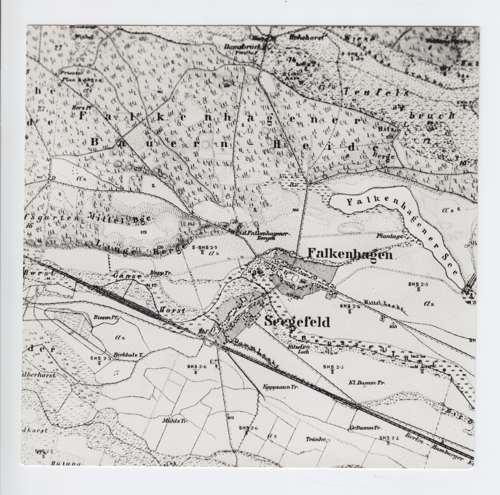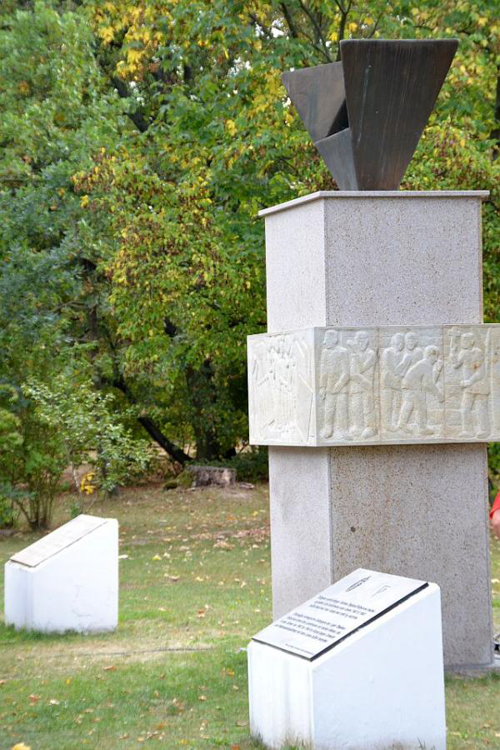Welcome
As mayor a.D. of the city of Falkensee I warmly welcome
you on the website of the history of the city of Falkensee. This page informs
about the development of our city and also includes texts and illustrations of
the panels that have been erected in the city area since 2019 in historically
significant locations and also on the historical park. In the coming months and years more panels will follow. All texts and illustrations are summarized on this
website.
Genesis
Today's Falkensee was created by the merger of two
villages: Falkenhagen and Seegefeld. While Seegefeld was first mentioned in
documents in 1265, Falkenhagen found its first written mention only in 1336.
Both villages are referred to in the original sense as Angerdörfer. Seegefeld
has in contrast to Falkenhagen a special feature: the manor. The large estate,
with manor house and farm, was in the center of the small village in
Brandenburg. Today, the name "Am Gutspark" testifies to its former existence. In 1777 the inn "Finkenkrug" was built, which
was later called "Alter Finkenkrug". In his "Walks through the
Mark Brandenburg" Theodor Fontane reports about the "Finkenkrug"
and about the diverse nature of Bredower forest. Trippers discovered the surroundings. Like Fontane, the
Berliners, Spandauer and Charlottenburger flocked to Finkenkrug. The historical
place Finkenkrug was off the village centers and belonged to the territory of
the Damsbrück forest estate The manor in Seegefeld was acquired in 1888 by Bernhard
Ehlers from Berlin. He parceled out and sold land to people willing to settle
in Berlin and the surrounding area. The first real estate sales date to the
year 1892. The German Settlement Bank took over in 1898 large parts of the
manor to continue the parcelling in the sense of Ehlers - the "colony
Neufinkenkrug" arises. The construction of the Berlin - Hamburg railway in 1846
was decisive for this rapid development. Two years later, in 1848, the first
trains stopped in Seegefeld. Not only the travel enthusiasts from Berlin and
the surrounding area discovered the wonderful surroundings by train connection,
but also tradesmen and tradesmen recognized the advantages of a railway siding.
An important prerequisite for the settlement of trade and industry. The railway station in Seegefeld, which became Falkensee
station in 1927, and the railway station in Finkenkrug were all in keeping with
the architecture of Märkischer Bahnhofs in the mid-19th century. They did not
stay. Since the end of the 19th century, colonies arose on the
one hand on former manor estate (Neufinkenkrug and Neufinkenkrug) or on
farmland (Falkenhain and Falkenhagener Alps) were. The large plots of land,
marked by a lot of greenery, made the newly opened settlement areas a coveted
residential area at the gates of Spandau and nearby Berlin. 1st April 1923: The place name Falkensee arises. From
Falkenhagen and Seegefeld the new community Falkensee is being built. April 1, 1927: incorporation of the manor Seegefeld, with
the oldest colony Neufinkenkrug. October 1, 1928: Incorporation of the forest estate
Damsbrück, with the colony Falkenhöh and the settlement "Alter
Finkenkrug".

Foto: Repro. Messtischblatt „Section Rohrbeck", 1868 Archiv Museum Falkensee
Ernst Freimuth
Ernst Freimuth was since 1912 the first full-time
community leader of the community Falkenhagen. After the merger of the villages
Falkenhagen and Seegefeld (1923) he was also the first mayor of the new
community Falkensee. During his tenure important decisions were made for the
development of infrastructure and the development of additional land for
settlement construction. He remained in office until the end of 1933. The
Freimuthstraße opposite the town hall was named after him.

Foto: Archiv Museum Falkensee
Time between 1933-1945
From 1943, one of the largest satellite camps of the
concentration camp Sachsenhausen was built on the eastern edge of Falkensee. In
ten blocks, the prisoners' housing barracks, lived up to 2,500 male prisoners
from almost all European nations. They were under inhuman conditions for forced
labor in the near Demag plant, which later in the Alkett GmbH, forced to
the production of war weapons. In April 1945, the prisoners resisted the evacuation
order. After the guards had left their posts, the prisoners
received their Soviet liberators on 25/26 April 1945 and left the camp
"free to the gate". The Falkensee-based armaments factories were dismantled
as reparations to the Soviet Union until 1949. The former camp area with parts
of the existing original buildings is a historical park of the city Falkensee a
memorial place for the victims of the national socialism.

Foto: Stadt Falkensee
A difficult beginning
On the site of the former concentration camp satellite
camp, in the former prisoner barracks, the largest quarantine warehouse in the
eastern Havelland was established from summer 1945. Many refugees from the
eastern territories, parents without children and returning prisoner of war
soldiers found here admission and a first medical care. The population increased in the following years to 31,000
inhabitants. Only years later did this situation relax with a
prescribed immigration stop. In 1951, after decades of planning, Falkensee was
connected to the S-Bahn Berlin network. The rapid-transit railway ended at
today's station Falkensee. The Finkenkrug station was also built as a S-Bahn
station, but no longer connected to the S-Bahn network. The community Falkensee lost between 1945 and 1961 a
large part of the population. Many "Ausgebomte" moved back to the new
apartments built in Berlin. War refugees moved on and many
"Urfalkenseer" moved out of fear of feared restrictions in the
western sectors of the city of Berlin. With the construction of the Berlin Wall on August 13,
1961, the lifeline from Falkensee to Berlin was cut. As a result, Falkensee
lost its locational advantage as a Berlin suburban community and now existed in
the "shadow" of the walled-in West Berlin as a relatively large city
distant community on. Many falconers lost Falkenseer not only their work on
this day, but also the family contact with the relatives in "West
Berlin". After a spectacular breakthrough of the border
fortification in Albrechtshof station on December 5, 1961 with a passenger
train with steamlock on the then not yet dismantled tracks, the long-distance
railway tracks of the Hamburger Bahn were dismantled. A few weeks after the Wall was built, the municipality of
Falkensee was granted city rights. The award document dates from October 7,
1961, the twelfth "National Holiday of the GDR," and is on display in
the Museum and Falkensee Museum. With the city law was from the "largest rural
community in Europe" a rather small East German city.
Fall of the Berlin Wall
Since Falkensee emerged from the wall shadow in 1989 with
the peaceful revolution in the GDR and the fall of the Berlin Wall and the
subsequent reunification of Germany, the city is experiencing a construction
boom and population growth, which accelerated the growth of the former rural
community in the 1920s and 30s even better in the last century. This
development was stopped at that time by war and wall construction and could be
continued only in the 1990er years. Large-scale housing construction in the form
of terraced houses, apartment blocks and townhouses was created by the
"Gartenstadt Falkenhöh", the "Parkstadt" in the residential
area Finkenkrug or "Seegefeld-Ost." For many newcomers, the many
possibilities are still attractive To build a detached house on previously
undeveloped land in mature residential streets.

Foto: Steffen Hinz
From young...
Falkensee is a young city in every respect. Only in 1961
she got the city rights. But not only that makes her so youthful. With the
immigration settle and settle above all young families and those can Falkensee
also offer a lot. With 24 facilities and a wide range of maternity services,
the city has a dense network of care. Three elementary schools have been newly
built since the fall of the Wall, other schools have been completely
refurbished, yet Falkensee is not satisfied with that: in the coming years, day
care centers and schools will also be brought up to date.
...to old...
But also for older people Falkensee is an attractive
city. Not a few prefer to retire at retirement age because their children live
here. There are various age-appropriate forms of accommodation and many clubs
and organizations that offer leisure activities for seniors. A rich cultural
and sports landscape offers something for everyone.

Foto: Steffen Hinz
... the gateway to Havelland
Just beyond the western gates of Berlin begins Havelland.
This is felt everywhere in his biggest city. The Falkenhagener and the New
Lake, the Lindenweiher and the Schlaggraben, the adjacent Bredower Forst, the
cozy residential area Waldheim as well as the many green areas make the city.







